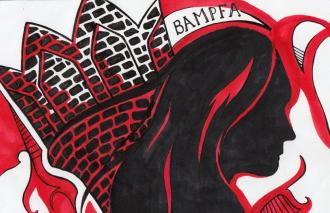Against the slick, white, barren surfaces of the Berkeley Art Museum and Pacific Film Archive, or BAMPFA, the red bricks, earthy tones and stained tactile facades of Martin Wong’s paintings bleed together like beautiful and deliberate stains on the wall.
From Sept. 20 to Dec. 10, BAMPFA will be showcasing the first exhibition of Wong’s paintings in two decades with the “Martin Wong: Human Instamatic” exhibit curated by Adjunct Curator Constance M. Lewallen.
Self-portraits and calligraphic poems from his formative years, visceral depictions of multi-ethnic urban landscapes created during his prime and mysterious figures of his mother’s cacti produced toward the close of his life and career largely form the heart of the BAMPFA exhibit. Lewallen has organized the show to highlight some of the most distinct subjects, styles and motifs that Wong revisits and leaves throughout his years, largely inspired by the environment he’s situated in at a given time.
The first section of the exhibit introduces some of Wong’s early experimentation with the bubbly form and exaggerated proportions — seen in works such as his “Portrait of Bill McWhorter in Convertible with Boy and Dog” — that would become more consistent and poignant in his succeeding years.
But this section is also interspersed with poems written in ink on large vertical parchment paper that pay homage to his Chinatown upbringing as well as portraits that recall to his days as a meager street artist creating under the pseudonym “Human Instamatic.” It makes the introductory part of the exhibit a bit chaotic — but necessarily so — in order to show just how eclectic his background and artistic taste initially were and continued to be.
We travel from San Francisco’s Chinatown (the city that nurtured and influenced his style in his later works) to the Lower East Side of New York, and we see that Wong frequently turned to the rubble and grittiness of his urban neighborhood to imbue his work with social realist elements.
In keeping with this vision, partitions then guide viewers onto Wong’s most definitive works created during his time in New York’s Lower East Side or, more specifically, Loisaida — a section of the Lower East Side with a predominantly Black and Puerto Rican demographic. Here, newcomers to Wong’s paintings will quickly catch on to his affinity for earthy and muted tones, the brick, metal and concrete of the surrounding streetscape, overly muscular figures and squared hand signs reminiscent of Olmec glyphs.
Since the exhibit is organized around the different landscapes Wong inhabited, the paintings are generally ordered in chronological fashion by decade (early ‘70s in San Francisco, late ‘70s to ‘80s in New York and ‘90s back in San Francisco) with a few paintings anachronistically presented to demonstrate a consistency in Wong’s most recurring themes and subjects such as sexuality, racial identity and cross-culturalism.
But there is a small caveat to the method Lewallen has used to curate “Human Instamatic.” Despite his “singular aesthetic,” Wong’s subject matters, color palette and themes are just as eccentric and varied as his personal experiences and the diverse communities he grew up in.
The clay reds, browns, blacks and grays that are centralized in the room are occasionally interrupted with vivid hues of blue — such as in “La Iglesia de Dios,” 1986 — and jade green in the borders of the exhibit. And as we approach the final years of Wong’s career, the closing section of “Human Instamatic” is a testimony to his wandering eye and mind.
One of the more curious departures from Wong’s usual subject matter of urban landscapes and earth-tone palette includes ephemeral depictions of cacti found in his mother’s backyard, restricting the painting to shades of white and black.
Throughout “Martin Wong: Human Instamatic,” the sounds of a crowded restaurant, store owners and Wong’s voice from Charlie Ahearn’s 1998 documentary of the artist eerily echoes like a faint transient specter. But the exhibit is a vivid and stark impression of Wong’s artistic style and his intimate, unique relationship with the community that will come to define him as an artist.
Despite his untimely death from AIDS-related causes in 1999, Wong’s legacy will continue to carry on in and beyond BAMPFA.
